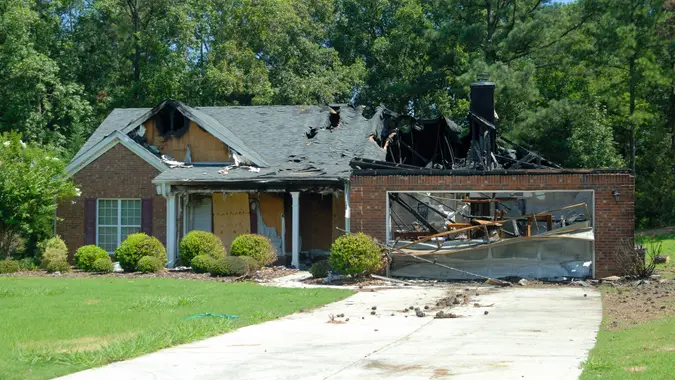How To Get a Special Tax Deferral If You Lost Your Home in a Disaster

Commitment to Our Readers
GOBankingRates' editorial team is committed to bringing you unbiased reviews and information. We use data-driven methodologies to evaluate financial products and services - our reviews and ratings are not influenced by advertisers. You can read more about our editorial guidelines and our products and services review methodology.

20 Years
Helping You Live Richer

Reviewed
by Experts

Trusted by
Millions of Readers
Most homeowners view their home as their largest investment and do what they can to keep it in good condition. However, natural disasters can derail those efforts.
Some of these disasters damage homes, while others can wipe out entire neighborhoods. People around the world were reminded of that grim reality during the recent wildfires in Los Angeles. These disasters have negative impacts on many people and communities.
A tax deferral isn’t at the top of anyone’s mind during a natural disaster. Everyone’s safety and knowing how you’ll bounce back are more important. However, you can claim a special tax deferral if you lost your home in a disaster.
Knowing about this perk can minimize your tax bill and reduce the financial impact of a disaster.
How To Get a Special Tax Deferral If You Lost Your Home
While tax deferrals don’t let you off the hook, they can keep taxes at bay as you rebuild your home. Holden Andrews, the founder of Helpful Home Group, explained how LA homeowners can get the special tax deferral.
“Homeowners in Los Angeles are able to get a reassessment of their taxes if they have suffered more than $10,000 in damages due to a natural disaster such as the fires that just occurred in Los Angeles. They need to go to this link and fill out form ADS 820,” he said.
Getting the deferral can be a little more complicated if a mortgage provider pays the property taxes on your behalf. However, there is still a benefit to filling out the form, even if the mortgage provider handles the taxes, Andrews explained.
“If the ADS 820 form is approved, this will reassess their property taxes and get some relief, as well as allow homeowners to defer property tax payments,” he said. “If they pay their property taxes through a mortgage provider, this form does not automatically do the deferment, but it does reassess them.”
You Have To Act Quickly
The government offers a generous window of opportunity to request a special tax deferral. Acting as soon as possible will ensure that you don’t forget to submit your form. Andrews provides more clarity on the deadline plus what types of property qualify for this opportunity.
“This needs to be done within 12 months, so doing it sooner rather than later is important. This can apply to things such as boats, RVs, or planes, and it doesn’t just have to be real property. There is an FAQ here that people can read and get more information,” he elaborated.
One of the FAQs is about the property’s assessment. The property will be reassessed in its damaged state, but it will be reassessed again once it is fully repaired, restored or reconstructed.
You will end up with the same property taxes that you had before the disaster if the property’s full cash value does not exceed 120% of the full cash value of the older damaged or destroyed improvement. That means you can make a property 110% of its pre-disaster full cash value without paying higher property taxes than you did before the natural event took place.
 Written by
Written by  Edited by
Edited by 

























